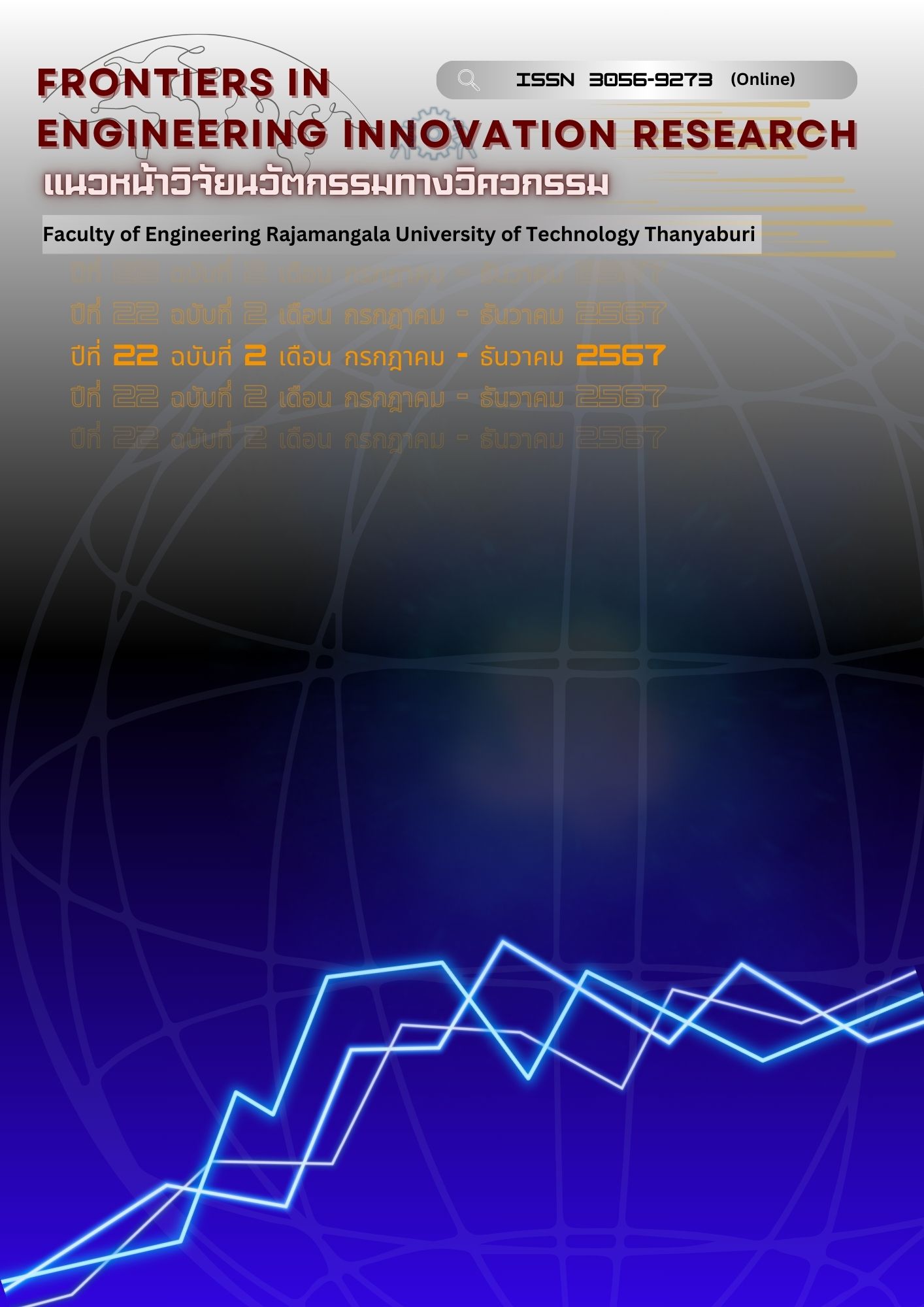การประยุกต์ใช้ฮาร์ดแวร์เสมือนจริงสำหรับการติดตามกำลังไฟฟ้าสูงสุดของ แผงเซลล์แสงอาทิตย์ด้วยวิธีโครงข่ายประสาทเทียม
Main Article Content
บทคัดย่อ
ฮาร์ดแวร์เสมือนจริงเป็นเทคโนโลยีสำหรับการจำลองฮาร์ดแวร์แบบวนซ้ำที่มีความน่าเชื่อถือสูง โดยไม่ต้องสร้างระบบจริงทำให้ประหยัดต้นทุน และช่วยลดระยะเวลาในการพัฒนาระบบ บทความนี้นำเสนอการประยุกต์ใช้ฮาร์ดแวร์เสมือนจริงรุ่น HIL404 สำหรับระบบการติดตามกำลังไฟฟ้าสูงสุดของแผงเซลล์แสงอาทิตย์ด้วยวิธีโครงข่ายประสาทเทียม ระบบประกอบด้วยแผงเซลล์แสงอาทิตย์ต่อร่วมกับวงจรยกระดับแรงดันโดยการปรับค่าวัฏจักรทำงานให้เหมาะสมเพื่อจ่ายกำลังไฟฟ้าสูงสุดให้กับโหลด วิธีการสร้างแบบจำลองโครงข่ายประสาทเทียมในฮาร์ดแวร์เสมือนจริงถูกสร้างจากโปรแกรม Matlab/Simulink ผ่านฟังก์ชัน fmi ซึ่งเป็นวิธีการที่ลดความซับซ้อน แผงเซลล์แสงอาทิตย์รุ่น DXP72-Z-330 ต่ออนุกรมกัน 7 แผง ซึ่งมีพิกัดแรงดัน 261 V ที่กำลังไฟฟ้าสูงสุด 2,300 W ถูกนำมาใช้สำหรับเก็บข้อมูลค่าความเข้มรังสีอาทิตย์ ค่าอุณหภูมิ และค่าแรงดันไฟฟ้าเป็นเวลา 1 สัปดาห์ เพื่อสร้างแบบจำลองโครงข่ายประสาทเทียมแบบป้อนข้อมูลไปข้างหน้าโดยใช้การเรียนรู้แบบแพร่ย้อนกลับ ชุดข้อมูลที่ใช้สอนโครงข่ายประสาทเทียมคือค่าความเข้มรังสีอาทิตย์และอุณหภูมิ ส่วนผลลัพธ์ที่ต้องการคือค่าแรงดันไฟฟ้าของระบบซึ่งทำให้เกิดกำลังไฟฟ้าสูงสุด บทความนี้ได้ทดสอบและวิเคราะห์หาฟังก์ชันการแปลงที่เหมาะสมของโครงข่ายประสาทเทียมแบบ 1 ชั้นช่อนและแบบ 2 ชั้นซ่อน ผลที่ได้พบว่าฟังก์ชันที่เหมาะสมคือ Linear ค่าเฉลี่ยความคลาดเคลื่อนร้อยละสัมบูรณ์ของแบบ 1 ชั้นซ่อนมีค่า 31.114 ส่วนแบบ 2 ชั้นซ่อนมีค่า 8.248 โดยโครงข่ายประสาทเทียมแบบ 2 ชั้นซ่อนมีเกณฑ์การพยากรณ์ค่อนข้างแม่นยำ นอกจากนี้บทความได้ทดสอบเปรียบเทียบสมรรถนะของระบบการติดตามกำลังไฟฟ้าสูงสุดแบบโครงข่ายประสาทเทียม 1 ชั้นซ่อน และ 2 ชั้นซ่อน กับวิธีการรบกวนและสังเกต โดยใช้ชุดข้อมูล 1,200 ข้อมูล โหลดเป็นความต้านทาน 45 ผลทดสอบที่ได้ระบบการติดตามกำลังไฟฟ้าสูงสุดแบบโครงข่ายประสาทเทียม 2 ชั้นซ่อน เกิดค่ากำลังไฟฟ้าที่โหลดสูงกว่าแบบวิธีการรบกวนและสังเกตเล็กน้อยและสามารถติดตามกำลังไฟฟ้าสูงสุดได้ถูกต้อง
Article Details

This work is licensed under a Creative Commons Attribution-NonCommercial-NoDerivatives 4.0 International License.
บทความ ข้อมูล เนื้อหา รูปภาพ ฯลฯ ที่ได้รับการตีพิมพ์ในวารสารแนวหน้าวิจัยนวัตกรรมทางวิศวกรรม ถือเป็นลิขสิทธิ์ของวารสารฯ เท่านั้น ไม่อนุญาติให้บุคคลหรือหน่วยงานใดคัดลอกเนื้อหาทั้งหมดหรือส่วนหนึ่งส่วนใดไปเผยแพร่เพื่อกระทำการใด ๆ ที่ไม่ถูกต้องตามหลักจริยธรรม
References
Goni O, Sanchez A, Todorovich E, Castro AD. Resolution analysis of switching converter models for hardware-in-the-loop. IEEE Transactions on Industrial Informatics. 2014;10(2):1162-70.
Park S, Moura S, Lee K. Integration of hardware and software for battery Hardware-in-the-Loop toward battery artificial Intelligence. IEEE Transactions on Transportation Electrification. 2024;10(1): 888-900.
Debnath S. Xia Q. Dong Z. Marthi PRV. Marti S. Kondabathini A. Control system of multi-port autonomous reconfigurable solar power plant (MARS) & HIL platforms for design. IEEE Transactions on Sustainable Energy. 2024;15(3):1423-34.
Rodrguez-Contreras SF, Salgado-Herrera NM, Robles M, Rodríguez-Rodríguez JR, Gonzalez-Cabrera N, Santoyo-Anaya MA. Photovoltaic energy conversion system integrated into unbalanced distribution electrical networks through hardware in the loop. IEEE Journal of Emerging and Selected Topics in Power Electronics. 2022;10(15):5614-25.
Mishra S, Ziar H, Isabella O, Zeman M. Selection map for PV module installation based on shading tolerability and temperature coefficient. IEEE Journal of Photovoltaics. 2019;9(3):872-80.
Burduhos BG, Visa I, Duta A, Neagoe M. Analysis of the conversion efficiency of five types of photovoltaic modules during high relative humidity time periods. IEEE Journal of Photovoltaics. 2018;8(6):1716-24.
Khoo YS, Nobre A, Malhotra R, Yang D, Ruther R, Reindl T, et al. Optimal orientation and tilt angle for maximizing in-plane solar irradiation for PV applications in Singapore. IEEE Journal of Photovoltaics. 2014;4(2):647-53.
Dallago E, Liberale A, Miotti D, Venchi G. Direct MPPT algorithm for PV sources with only voltage measurements. IEEE Transactions on Power Electronics. 2015;30 (12):6742-50.
Salman S, Ai X, Wu Z. Design of a P&O algorithm based MPPT charge controller for a stand-alone 200W PV system. Protection and Control of Modern Power Systems. 2018;3(3):1-8.
Sera D, Mathe L, Kerekes T, Spataru SV, Teodorescu R. On the perturb and observe and incremental conductance MPPT methods for PV systems. IEEE Journal of Photovoltaics. 2013;3(3):1070-8.
Ali M, Tariq M, Lodi KA, Chakrabortty RK, Ryan MJ, Alamri B, et al. Robust ANN-based control of modified PUC-5 inverter for solar PV applications. IEEE Transactions on Industry Applications. 2021;57(4):3863-76.
Yap KY, Sarimuthu CR, Lim JMY. Artificial intelligence based MPPT techniques for solar power system: a review. Journal of Modern Power Systems and Clean Energy. 2020;8(6):1043-59.
Kiran SR. Basha CHH. Singh VP. Dhanamjayulu C. Prusty BR. Khan B. Reduced simulative performance analysis of Variable step size ANN based MPPT techniques for partially shaded solar PV systems. IEEE Access. 2022;10:48875-89.
Yilmaz M. Celikel R. Gundogdu A. Enhanced photovoltaic systems performance: anti-windup PI controller in ANN-based ARV MPPT method. IEEE Access. 2023;11:90498-09.
Kayisli K, Caglayan RZ, Colak I. PV-MPPT Lab: A GUI-based education tool for MPPT techniques. IEEE Transactions on Education. 2024;67(3):453-61.
Runze L, Zhu Y, Yang Y. Robust design of perturb & observe maximum power point tracking for photovoltaic systems. IEEE Transactions on Industry Applications. 2024;60(4):6547-58.
Alhusseini H, Niroomand M, Dehkordi BM. A fuzzy-based adaptive P&O MPPT algorithm for PV systems with fast tracking and Low oscillations under rapidly irradiance change conditions. IEEE Access, 2024;12:84374-86.
Ye SP, Liu YH, Pai HY, Sangwongwanich A. Blaabjerg F. A novel ANN-based GMPPT method for PV systems under complex partial shading conditions. IEEE Transactions on Sustainable Energy, 2024;15(1):328-38.
Bana PR, Arco SD, Amin M. ANN-based robust current controller for single-stage grid-connected PV with embedded Improved MPPT scheme. IEEE Access. 2024;12:100251-62.

